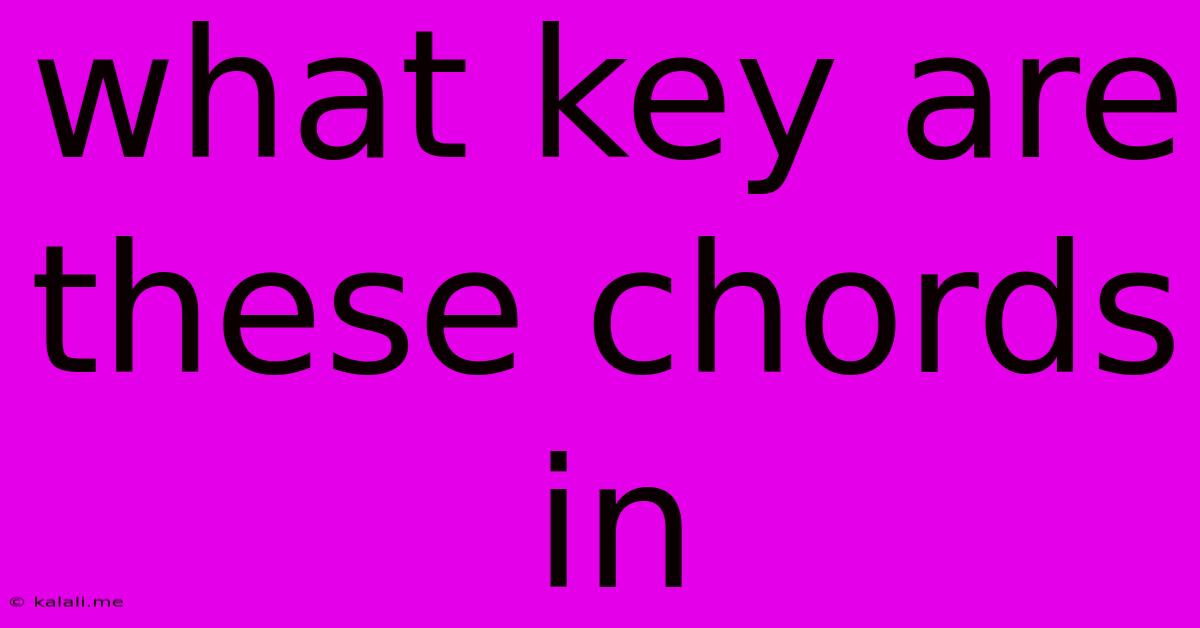What Key Are These Chords In
Kalali
May 20, 2025 · 3 min read

Table of Contents
What Key Are These Chords In? A Guide to Chord Analysis
Determining the key of a song based on its chords is a fundamental skill for any musician. This guide will walk you through the process, equipping you with the knowledge to analyze chord progressions and identify the underlying key. Understanding this will greatly improve your songwriting, improvisation, and overall musical understanding. This article will cover major and minor keys, common chord progressions, and how to handle exceptions.
Understanding Major and Minor Keys:
Every key has a unique "home" note – the tonic. Major keys sound bright and upbeat, while minor keys sound darker and more melancholic. The chords within a key are built using the notes within its scale.
-
Major Key: The major scale consists of seven notes with a specific intervallic pattern: whole, whole, half, whole, whole, whole, half. The chords built from the I, IV, and V degrees of the major scale are the most commonly used.
-
Minor Key: The natural minor scale follows a different pattern: whole, half, whole, whole, half, whole, whole. Similar to major keys, the i, iv, and v chords are prevalent in minor key progressions.
Analyzing Chord Progressions:
The simplest way to determine a key is by identifying the tonic chord – the I chord. This is usually the chord that appears most frequently and provides a sense of resolution. Let's look at some examples:
Example 1: C Major
If a song primarily uses the chords C Major (I), G Major (V), and F Major (IV), it's highly likely in the key of C Major. The presence of these chords, especially C Major, strongly suggests C as the tonic.
Example 2: A Minor
A song predominantly featuring A minor (i), E minor (v), and C Major (IV) suggests the key of A minor. Again, the most frequent chord and the overall feeling of the progression help determine the key.
Example 3: More Complex Progressions:
Sometimes, chord progressions are more intricate, involving borrowed chords from parallel keys or relative minors/majors. For instance, a song might use chords from both the major and relative minor keys. In these cases, you need to consider:
- Frequency of Chords: Which chord appears most often?
- Resolution: Where does the progression naturally resolve?
- Overall Feeling: Does the piece sound major or minor?
Handling Exceptions and Borrowed Chords:
Not all songs will follow strict rules. Composers often "borrow" chords from parallel or relative keys to create interesting harmonic variations. For example, a song in C major might include the chord Am (from the relative minor key, A minor). While these borrowed chords add color, the overall harmonic context usually still points towards a primary key.
Tips for Accurate Key Identification:
- Listen to the melody: The melody often emphasizes the tonic note of the key.
- Consider the bass line: The bass line frequently outlines the chord changes and can highlight the root notes.
- Use a music theory software or app: Many apps can analyze audio and identify the key. This can be a helpful tool for confirmation.
Conclusion:
Determining the key of a series of chords requires practice and a keen ear. By understanding major and minor scales, recognizing common chord progressions, and considering the overall harmonic context, you can confidently analyze music and deepen your understanding of musical theory. Remember to focus on the most frequently used chord, the resolution points, and the overall mood to accurately determine the key.
Latest Posts
Latest Posts
-
How To Stop Squealing Fan Belt
May 20, 2025
-
What Percentage Of Masters Students Get A Distinction Uk
May 20, 2025
-
One Who Is Wise Beyond Their Years
May 20, 2025
-
How Long Noah Was In The Ark
May 20, 2025
-
How Long Does Ice Cream Take To Freeze
May 20, 2025
Related Post
Thank you for visiting our website which covers about What Key Are These Chords In . We hope the information provided has been useful to you. Feel free to contact us if you have any questions or need further assistance. See you next time and don't miss to bookmark.